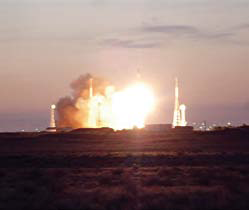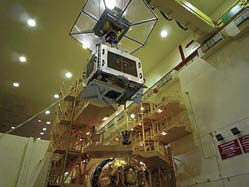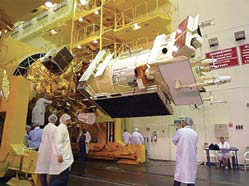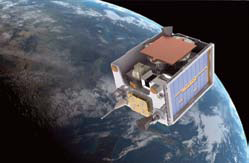Surrey Satellite Technology Ltd (SSTL) has successfully launched their TechDemoSat-1, an in-orbit technology demonstration mission designed and implemented for innovative UK spacecraft equipment and software.

Liftoff of TechDemoSat-1 aboard a Soyuz-2 launch vehicle. Photo is courtesy of SSTL.
The spacecraft was launched into 635km sun-synchronous orbit on board a Soyuz-2 launch vehicle with a Fregat upper stage from the Baikonur Cosmodrome in Kazakhstan at 15:58:28 UTC on July 8th, 2014. Following confirmation of separation from the launch vehicle, the ground station at the Satellite Applications Catapult Operations Centre at Harwell established contact with TechDemoSat-1 on its first pass and commissioning of the platform was initiated, undertaken by the Operations team from SSTL. TechDemoSat-1 is the first satellite to be operated from the company’s new facility at Harwell.
TechDemoSat-1 is based on the SSTL-150 platform and is part-funded by a grant from the UK’s Technology Strategy Board, and SEEDA (South East England Development Agency). The spacecraft carries eight separate payloads from UK academia and industry, providing valuable in-orbit validation for new technologies. The payloads flying on TechDemoSat-1 are:

The TechDemoSat-1 satellite being lifted by crane toward the Fregat upper stage. Photo courtesy of SSTL.
• MuREM, a flexible miniature radiation and effects monitor from Surrey Space Centre
• ChaPS, a prototype compact instrument to detect electrons and ions from the Mullard Space Science Laboratory
• HMRM, a lightweight, ultra-compact radiation monitor designed to measure total radiation dose, particle flux rate and identify electrons, protons and ions from Rutherford Appleton Laboratory and Imperial College
• LUCID, a device to measure characterization of the energy, type, intensity and directionality of high energy particles from the Langton Star Centre
• Compact Modular Sounder system, a modular infrared remote sensing radiometer unit from Oxford University’s Planetary Group and Rutherford Appleton Laboratory
• De-orbit sail from Cranfield University
• Cubesat ADCS, a 3-axes attitude determination and control subsystem from SSBV
• Sea State Payload, a device using an enhanced GPS receiver from SSTL and components from a Synthetic Aperture Radar from Airbus Defence and Space to monitor reflected signals to determine ocean roughness
Commissioning of the payloads on board the satellite will be performed by SSTL via its own Mission Control Centre in Guildford, before handing over day-to-day operation of the payloads back to the Catapult. SSTL will continue to manage spacecraft level monitoring and operations for TechDemoSat-1 in Guildford.

TechDemoSat-1 being integrated onto the Fregat upper stage along with all of the additional satellites on this launch. Photo is courtesy of SSTL.
Universities and Science Minister David Willetts said, “The successful launch of TechDemoSat-1 has given UK space companies a unique opportunity to test their cutting-edge technologies in orbit. These innovators can now show investors and potential customers how their products perform in the harsh environment of space. TechDemoSat-1 is also the first satellite to be controlled by the Satellite Applications Catapult. This was established by the Government to harness the success of the UK space sector and its world-leading companies like SSTL.”
Luis Gomes, Director of Earth Exploration and Science at SSTL, said, “The successful launch of the TechDemoSat-1 satellite marks the end of an exciting spacecraft build challenge for SSTL, with no less than eight payloads and more than 25 of our own engineering developments on-board. We can now look forward to the mission phase, where data is returned from the satellite in orbit and we, alongside our payload providers, can prove new concepts in space.”

Artistic rendition of TechDemoSat-1 on orbit over Earth. Image courtesy of SSTL.
Iain Gray, Chief Executive of the Technology Strategy Board, said, “The TechDemoSat-1 project is an excellent example of how our space program is supporting business innovation in new applications using satellite data and space-based systems. This significant project is the first in-orbit satellite project directly funded by the Technology Strategy Board. It allows us to provide UK businesses with an in orbit demonstration platform to test several new satellite-based products and services - a fantastic way to support innovation in the space sector and help businesses take advantage of the growing space market.”
The SSTL infosite may be reached at http://www.sstl.co.uk/

